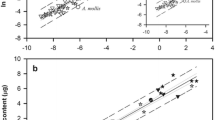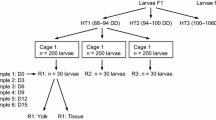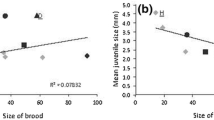Abstract
Lipid and protein biochemistry of eggs (84 μm in diameter), embryos and early larvae of the tropical echinoid Tripneustes gratilla (Linnaeus 1758) were quantified to determine how maternal provisions are used to fuel development of the echinopluteus. The eggs contained a mean of 30.82 ng lipid and 87.32 ng protein. Energetic lipids were the major lipid component (55.52% of total lipid) with the major class being triglyceride (TG: mean 15.9 ng, 51.58% of total). Structural lipid was dominated by phospholipid (PL: mean 11.18 ng, 36.26% of total). Early embryogenesis was not a major drain on egg energetic lipid and protein. Development of the functional feeding larva used ca. 50% of initial egg energetic lipid and most of this was TG. Maternal TG was still present in the 8-day echinoplutei and it was estimated that this energetic lipid would be depleted in unfed larvae by day 10. There was no change in PL. In a separate experiment lipid biochemistry of rudiment stage larvae and early developing juveniles were quantified to determine how lipids are used during metamorphosis. Fed larvae accumulated lipid (mean 275.49 ng) with TG and PL being the major energetic and structural lipids, respectively. Larval lipid stores were not appreciably depleted by metamorphosis and so were available for the early benthic stage juvenile. Juveniles started their benthic existence with 314 ng total lipid (TG: mean 46.84 ng, 14.9% of total, PL: mean 137.51 ng, 43.67% of total). Nile Red histochemistry and histology showed that the stomach serves as a nutrient storage organ and, that lipid stores accrued by larvae sustain developing juveniles for up to 4 days post settlement. Triglyceride supported both non-feeding stages of development and the prefeeding larval and perimetamorphic benthic stage. In this first study of lipid stores in settlement stage echinoderm larvae, we show that T. gratilla larvae sequester the same major energetic lipid (TG) to support the early juvenile that the female parent provided them to fuel early development.





Similar content being viewed by others
References
Allen JD, Zakas C, Podolsky RD (2006) Effects of egg size reduction and larval feeding on juvenile quality for a species with facultative-feeding development. J Exp Mar Biol Ecol 331:186–197
Bochenek EA, Klink JM, Powell EN, Hofmann EE (2001) A biochemically based model of the growth and development of Crassotrea gigas larvae. J Shellfish Res 20:243–265
Byrne M, Cerra A (2000) Lipid dynamics in the embryos of Patiriella species with divergent modes of development. Dev Growth Differ 42:79–86
Byrne M, Villinski J, Popodi E, Cisternas P, Raff R (1999) Maternal factors and the evolution of developmental mode: Evolution of oogenesis in Heliocidaris erythrogramma. Dev Genes Evol 209:275–283
Byrne M, Cisternas P, Selvakumaraswamy P, Villinski JT, Raff RR (2003) Evolution of maternal provisioning in ophiuroids, asteroids and echinoids. In: Feral JP, David B (eds) Echinoderm research 2001. A.A. Balkema, Lisse, pp 171–175
Byrne M, Sewell MA, Prowse TAA (2008) Nutritional ecology of sea urchin larvae: influence of endogenous and exogenous nutrition on echinopluteus growth and phenotypic plasticity in Tripneustes gratilla. Funct Ecol 22:643–648
Carman KR, Thistle D, Ertman SC, Foy M (1991) Nile red as a probe for lipid-storage in benthic copepods. Mar Ecol Prog Ser 74:307–311
Chen C-P, Run J-Q (1988) Some aspects of rearing larvae and larval development of Tripneustes gratilla (L.) (Echinodermata: Echinoidea). Bull Inst Zool Acad Sin 27:151–157
Chia FS, Burke RD (1978) Echinoderm metamorphosis: fate of larval structures. In: Chia FS, Rice ME (eds) Settlement and metamorphosis of marine invertebrate larvae. Elsevier North Holland Biomedical Press, New York, pp 219–234
Dafni J (1992) Growth rate of the sea urchin Tripneustes gratilla elatensis. Isr J Zool 38:25–33
Dworjanyn SA, Pirozzi I (2008) Induction of settlement in the sea urchin Tripneustes gratilla by macroalgae, diatom biofilms and conspecifics: a role for bacteria? Aquaculture 274:268–274
Dworjanyn SA, Pirozzi I, Liu W (2007) The effect of the addition of algae feeding stimulants to artificial diets for the sea urchin Tripneustes gratilla. Aquaculture 273:624–633
Ebert TA (1982) Longevity, life history, and relative body wall size in sea urchins. Ecol Monogr 52:353–394
Emlet RB (1986) Facultative planktotrophy in the tropical echinoid Clypeaster rosaceus (Linnaeus) and a comparison with obligate planktotrophy in Clypeaster subdepressus (Gray) (Clypeasteroida: Echinoidea). J Exp Mar Biol Ecol 95:183–202
Emlet RB, Sadro SS (2006) Linking stages of life history: how larval quality translates into juvenile performance for an intertidal barnacle (Balanus glandula). Integr Comp Biol 46:334–346
Falkner I, Byrne M, Sewell MA (2006) Maternal provisioning in Ophionereis fasciata and O. schayeri: brittle stars with contrasting modes of development. Biol Bull 211:204–207
Fenaux L, Cellario C, Etienne M (1985) Variations in the ingestion rate of algal cells with morphological development of larvae of Paracentrotus lividus (Echinodermata: Echinoidae). Mar Ecol Prog Ser 24:161–165
Fenaux L, Strathmann MF, Strathmann RR (1994) 5 tests of food-limited growth of larvae in coastal waters by comparisons of rates of development and form of echinoplutei. Limnol Oceanogr 39:84–98
Gallager SM, Mann R, Sasaki GC (1986) Lipid as an index of growth and viability in three species of bivalve larvae. Aquaculture 56:81–103
George SB, Cellario C, Fenaux L (1990) Population differences in egg quality of Arbacia lixula (Echinodermata: Echinoidea): Proximate composition of eggs and larval development. J Exp Mar Biol Ecol 141:107–118
George SB, Young CM, Fenaux L (1997) Proximate composition of eggs and larvae of the sand dollar Encope michelini (Agassiz): the advantage of higher investment in plankotrophic eggs. Invert Reprod Dev 32:11–19
Gosselin P, Jangoux M (1998) From competent larva to exotrophic juvenile: a morphofunctional study of the perimetamorphic period of Paracentrotus lividus (Echinodermata, Echinoida). Zoomorphology 118:31–43
Hart MW (1995) What are the costs of small egg size for a marine invertebrate with a feeding planktonic larva? Amer Nat 146:415–426
Hart MW (1996) Evolutionary loss of larval feeding: development, form and function in a facultatively feeding larva, Brisaster latifrons. Evolution 50:174–187
Hentschel B, Emlet RB (2000) Metamorphosis of barnacle nauplii: effects of food variability and a comparison with amphibian models. Ecology 81:3495–3508
Herrera JC, McWeeney SK, McEdward LR (1996) Diversity of energetic strategies among echinoid larvae and the transition from feeding to nonfeeding development. Oceanol Acta 19:313–321
Holland DL, Gabbott PA (1971) A micro-analytical scheme for the determination of protein, carbohydrate, lipid and RNA levels in marine invertebrate larvae. J Mar Biol Assoc UK 51:659–668
Imagawa S, Nakano Y, Watanabe T (2004) Molecular analysis of a major soluble egg protein in the scleractinian coral Favites chinensis. Comp Biochem Physiol B 137:11–19
Jaeckle WB (1995) Variation in the size, energy content, and biochemical composition of invertebrate eggs: correlates to the mode of larval development. In: McEdward LR (ed) Ecology of marine invertebrate larvae. CRC Press, Boca Raton, pp 49–77
Juinio-Menez MA, Macawaris N, Bangi H (1998) Community-based sea urchin (Tripneustes gratilla) grow-out culture as a resource management tool. Can Spec Pub Fish Aquat Sci 125:393–399
Koike I, Mukai H, Nojima S (1987) The role of the sea urchin Tripneustes gratilla (Linnaeus), in decomposition and nutrient cycling in a tropical sea grass bed. Ecol Res 2:19–29
Kozhina VP, Terekhova TA, Svetashev VI (1978) Lipid composition of gametes and embryos of the sea urchin Strongylocentrotus intermedius at early stages of development. Dev Biol 62:512–517
Lawrence JM, Agatsuma Y (2007) Ecology of Tripneustes. In: Lawrence JM (ed) The biology and ecology of edible urchins. Elsevier Science, Amsterdam, pp 499–520
Lawrence JM, Bazhin A (1998) Life-history strategies and the potential of sea urchins for aquaculture. J Shellfish Res 17:1515–1522
Lamare MD, Barker MF (1999) In situ estimates of larval development and mortality in the New Zealand sea urchin Evechinus chloroticus (Echinodermata: Echinoidea). Mar Ecol Prog Ser 180:197–211
Lessios HA, Kane J, Robertson DR (2003) Phylogeography of the pantropical sea urchin Tripneustes: contrasting patterns of population structure between oceans. Evolution 57:2026–2036
López S, Turon X, Montero E, Palacín C, Duarte CM, Tarjuelo I (1998) Larval abundance, recruitment and early mortality in Paracentrotus lividus (Echinoidea), interannual variability and plankton-benthos coupling. Mar Ecol Prog Ser 172:239–251
Liu H, Kelly MS, Cook EJ, Black K, Orr H, Zhu JX, Dong SL (2007) The effect of diet type on growth and fatty acid composition of the sea urchin larvae, II. Psamechinus miliaris (Gmelin). Aquaculture 264:263–278
Marshall DJ, Keough MJ (2006) Complex life cycles and offspring provisioning in marine invertebrates. Integr Comp Biol 46:643–651
McEdward LR, Miner BG (2006) Estimation and interpretation of egg provisioning in marine invertebrates. Integr Comp Biol 46:224–232
McClintock JB, Baker BJ (1997) Palatability and chemical defence of eggs, embryos and larvae of shallow-water Antarctic marine invertebrates. Mar Ecol Prog Ser 154:121–131
Metzman MS, Mastroianni A, Strauss JF (1978) Fatty acid composition of unfertilized and fertilized eggs of the sea urchin, Arbacia punctulata. Lipids 13:823–824
Meyer E, Green AJ, Moore M, Manahan DT (2007) Food availability and physiological state of sea urchin larvae (Strongylocentrotus purpuratus). Mar Biol 152:179–191
Miles CM, Hadfield MG, Wayne ML (2007) Heritability for egg size in the serpulid polychaete Hydroides elegans. Mar Ecol Prog Ser 340:155–162
Miller BA, Emlet RB (1999) Development of newly metamorphosed juvenile sea urchins (Strongylocentrotus franciscanus and S. purpuratus): morphology, the effects of temperature and larval food ration, and a method for determining age. J Exp Mar Biol Ecol 235:67–90
Miner BG, Vonesh JR (2004) Effects of fine grain environmental variability on morphological plasticity. Ecol Lett 7:794–801
Miner BG, McEdward LA, McEdward LR (2005) The relationship between egg size and the duration of the facultative feeding period in marine invertebrate larvae. J Exp Mar Biol Ecol 321:135–144
Moran A, Emlet RB (2001) Offspring size and performance in variable environments: field studies on a marine snail. Ecology 82:1597–1612
Moran AL, Manahan DT (2003) Energy metabolism during larval development of green and white abalone, Haliotis fulgensi and H. sorenseni. Biol Bull 204:270–277
Olson RR, Olson MH (1989) Food limitation of planktotrophic marine invertebrate larvae: does it control recruitment success? Annu Rev Ecol Syst 20:225–247
Parrish CC (1987) Separation of aquatic lipid classes by chromarod thin-layer chromatography with measurement by Iatroscan flame ionisation detection. Can J Fish Aquat Sci 44:722–731
Parrish CC (1999) Determination of total lipid, lipid classes, and fatty acids in aquatic samples. In: Arts MT (ed) Lipids in freshwater ecosystems. Springer, New York, pp 4–20
Pechenik JA (2006) Larval experience and latent effects - metamorphosis is not a new beginning. Integr Comp Biol 46:323–333
Pechenik JA, Wendt DE, Jarrett JN (1998) Metamorphosis is not a new beginning. Bioscience 48:901–910
Pernet F, Tremblay R, Langdon C, Bourget E (2004) Effect of additions of dietary triacylglycerol microspheres on growth, survival, and settlement of mussel (Mytilus sp.) larvae. Mar Biol 144:693–703
Pernet F, Bricelj VM, Cartier S (2006) Lipid class dynamics during larval ontogeny of sea scallops, Placopecten magellanicus, in relation to metamorphic success and response to antibiotics. J Exp Mar Biol Ecol 329:265–280
Phillips NE (2002) Metamorphosis of barnacle nauplii: Effects of nutrition-mediated larval condition on juvenile performance. Ecology 83:2562–2574
Podolsky RD, Moran AL (2006) Integrating function across marine life cycles. Integr Comp Biol 46:577–586
Podolsky RD, Virtue P, Hamilton T, Vavra J, Manahan DT (1994) Energy metabolism during development of the antarctic sea urchin Sterechinus neumayeri. Antarct J US 29:157–158
Powell EN, Bochenek EA, Klink JM, Hofmann EE (2004) Influence of short-term variations in food on survival of Crassostrea gigas larvae: a modelling study. J Mar Res 62:117–152
Prowse TAA, Sewell MA, Byrne M (2008) Fuels for development: evolution of maternal provisioning in asterinid sea stars. Mar Biol 153:337–349
Quinn GP, Keough MJ (2002) Experimental design and data analysis for biologists. Cambridge University Press, Cambridge
Reitzel AM, Webb J, Arellano S (2004) Growth, development and condition of Dendraster excentricus (Eschscholtz) larvae reared on natural and laboratory diets. J Plankton Res 26:901–990
Scheibling RE, Mladenov PV (1987) The decline of the sea urchin, Tripneustes ventricosus fishery of Barbados: a survey of fisherman and consumers. Mar Fish Rev 49:62–69
Schiopu D, George SB, Castell J (2006) Ingestion rates and dietary lipids affect growth and fatty acid composition of Dendraster excentricus larvae. J Exp Mar Biol Ecol 328:47–75
Sewell MA (2005) Utilization of lipids during early development of the sea urchin Evechinus chloroticus. Mar Ecol Prog Ser 304:133–142
Sewell MA, Manahan DT (2001) Echinoderm eggs: biochemistry and larval biology. In: Barker M (ed) Echinoderms 2000. Swets & Zeitlinger, Lisse, pp 55–58
Sewell MA, Young CM (1997) Are echinoderm egg size distributions bimodal? Biol Bull 193:297–305
Sewell MA, Cameron MJ, McArdle BH (2004) Developmental plasticity in larval development in the echinometrid sea urchin Evechinus chloroticus with varying food ration. J Exp Mar Biol Ecol 309:219–237
Shimabukuro S (1991) Tripneustes gratilla. In: Shokita S, Yamaguchi M, Masashi M (eds) Aquaculture in tropical areas. Midori Shobo, Tokyo, pp 313–328
Shilling FM, Manahan DT (1990) Energetics of early development for the sea urchins Strongylocentrotus purpuratus and Lytechinus pictus and the crustacean Artemia sp. Mar Biol 106:119–127
Strathmann RR, Fenaux L, Strathmann MF (1992) Heterochronic developmental plasticity in larval sea-urchins and its implications for evolution of nonfeeding larvae. Evolution 46:972–986
Vaïtilingon D (2004) The biology and ecology of the echinoid Tripneustes gratilla (Linnaeus, 1758) off Toliara (Madagascar): feeding, reproduction, larval development, population dynamics and parasitism. Ph.D. hesis, Université libre de Bruxelles
Vaïtilingon D, Morgan R, Grosjean P, Gosselin P, Jangoux M (2001) Effects of delayed metamorphosis and food rations on the perimetamorphic events in the echinoid Paracentrotus lividus (Lamarck, 1816) (Echinodermata). J Exp Mar Biol Ecol 262:41–60
Vaïtilingon D, Rasolofonirina R, Jangoux M (2003) Feeding preferences, seasonal gut repletion indices, and diel feeding patterns of the sea urchin Tripneustes gratilla (Echinodermata: Echinoidea) on a coastal habitat off Toliara (Madagascar). Mar Biol 143:45–458
Vaïtilingon D, Rasolofonirina R, Jangoux M (2005) Reproductive cycle of edible echinoderms from the Southwestern Indian Ocean I. Tripneustes gratilla L. (Echinodermata: Echinoidea). Western Indian Ocean J Mar Sci 4:47–60
Vance RR (1973) On reproductive strategies in marine benthic invertebrates. Am Nat 107:339–352
Villinski JT, Villinski JC, Byrne M, Raff RA (2002) Convergent maternal provisioning and life-history evolution in echinoderms. Evolution 56:1764–1775
Yasumasu I, Hino A, Suzuki A, Mita M (1984) Change in the triglyceride level in sea urchin eggs and embryos during early development. Dev Growth Differ 26:525–532
Yokota Y, Kato KH, Mita M (1993) Morphological and biochemical studies on yolk degradation in the sea urchin, Hemicentrotus pulcherrimus. Zool Sci 10:661–670
Acknowledgments
The research was supported by the Australian Research Council (MB) and the University of Auckland Research Fund (MAS). Research in Madagascar was supported by Prof M Jangoux and funded by a grant from Coopération Universitaire au Développement of the French Community of Belgium. Mr I Pirozzi and New South Wales Department of Primary Industries provided technical assistance and facilities. Thanks to the reviewers for their helpful comments on the manuscript. The experiments complied with the current legislation of the country they were performed in (Australia or Madagascar).
Author information
Authors and Affiliations
Corresponding author
Additional information
Communicated by J. P. Grassle.
Rights and permissions
About this article
Cite this article
Byrne, M., Prowse, T.A.A., Sewell, M.A. et al. Maternal provisioning for larvae and larval provisioning for juveniles in the toxopneustid sea urchin Tripneustes gratilla . Mar Biol 155, 473–482 (2008). https://doi.org/10.1007/s00227-008-1045-5
Received:
Accepted:
Published:
Issue Date:
DOI: https://doi.org/10.1007/s00227-008-1045-5




